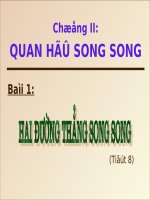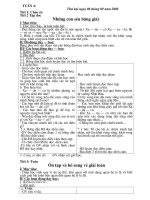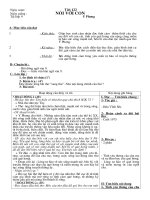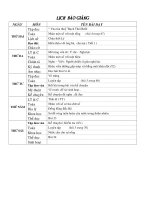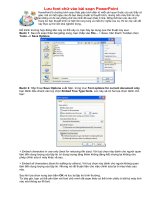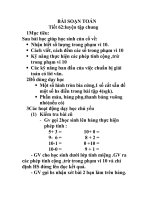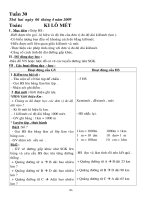Bài soạn RELATIVE PRONOUN
Bạn đang xem bản rút gọn của tài liệu. Xem và tải ngay bản đầy đủ của tài liệu tại đây (160.39 KB, 20 trang )
Chuyên đề:
CÁCH DÙNG CÁC ĐẠI TỪ QUAN HỆ
I. MỤC ĐÍCH CHUYÊN ĐỀ
Không phải ngẫu nhiên mà người ta coi đại từ quan hệ là
một trong “tứ trụ” trong cấu trúc tiếng Anh. Đại từ quan hệ
được sử dụng rất rộng rãi cả trong văn nói và trong văn viết.
II. KIẾN THỨC CƠ BẢN
Who – that (chủ ngữ chỉ người)
+The man is my teacher. The man is at the door.
- The man who(that)is at the door is my teacher.
(phần gạch chân là mệnh đề phụ tính ngữ bổ nghĩa cho “the man”).
The girl is from Vietnam. The girl is wearing red.
- The girl who is wearing red is from Vietnam.
Which – that (chủ ngữ chỉ vật)
+The book is interesting. The book is on the table.
-The book which is on the table is interesting.
+The pencil is Nam’s. The pencil is red and blue.
-The pencil which is red and blue is Nam’s.
Whom, which, that (tân ngữ)
3.1. Whom (dùng cho người), that (dùng cho cả người và vật),
which (dùng cho vật): là tân ngữ.
I know the man. You met the man yesterday.
- I know the man whom/ that you met yesterday.
I haven’t found the pen. I lost the pen yesterday.
-I haven’t found the pen which/ that I lost yesterday.
I don’t know the woman. You are talking about the woman now.
-I don’t know the woman whom/ that you are talking about now.
= I don’t know the woman about whom you are talking now. (không
dùng “that”)
We like the book. Your mother spoke about the book yesterday.
-We like the book which/ that your mother spoke about yesterday.
= We like the book about which your mother spoke yesterday. (không
dùng “that”)
Chú ý: Nếu giới từ đứng trước đại từ quan hệ thì không
dùng “that” .
Whose – of which (sở hữu)
I teach the children. Their house is next to mine.
- I teach the children whose house is next to mine.
I work in the school. The gate of the school is blue.
- I work in the school, of which the gate is blue.
= I work in the school, the gate of which is blue.
When = on which (day, date), when = in which (year)
I always remember the year . the war ended in that year.
- I always remember the year when/ in which the war ended.
She reminded me of the date. We first met on that date.
- She reminded me of the date when/ on which we first met.
Where = in (at, to) which
We visited the village last week. We were born in the village.
- We visited the village where/ in which we were born.
Why = for which
He told me the reason. He was late for the reason.
- He told me the reason why/ for which he was late.
Mệnh đề phụ tính ngữ xác định và không xác định
Mệnh đề phụ tính ngữ xác định: là thành phần cơ bản
trong câu, không thể thiếu, không thể bỏ đi được (kh«ng cã
dÊu ph¶y gi÷a hai mÖnh ®Ò).
The book is interesting. The book is on the table
- the book which is on the table is interesting.
Mệnh đề phụ tính ngữ không xác định: là mệnh đề cung
cấp thêm thông tin, là thành phần không cơ bản, có thể bỏ
đi được (gi÷a hai mÖnh ®Ò cã dÊu ph¶y, mệnh đề tính ngữ
không xác định khi thành phần trong câu đã được xác định
bằng tính từ sở hữu, së h÷u c¸ch, danh tõ riªng, tính từ chỉ
định hoặc yếu tố duy nhất).
Nam’s book is interesting. It is on the table.
- Nam’s book, which is on the table, is interesting.
Từ chỉ lượng với đại từ quan hệ
some of/most of/a lot of/both of/neither of/a pair of…+ whom/
which
I go to school with some friends. Most of them are boys.
- I go to school with some friends, most of whom are boys.
We sent him two pictures. Both of them were new.
- We sent him two pictures, both of which were new.
Các trường hợp không dùng “that”
Giới từ đứng trước đại từ quan hệ
I know the man with whom you live
Mệnh đề có chứa từ chỉ lượng
They met many children, most of whom were girls.
Đại từ quan hệ thay thế cả mệnh đề đứng trước nó
He often sailed across the lake, which nobody had done before.
THAT:
Sau 1 tiền trí từ hỗn hợp : (người vật lẫn lộn)
Ex: The old man and two dogs made much noise . They
passed my house yesterday.
The old man and two dogs that I passed my house
yesterday made much noise.
Sau 1 tính từ cực cấp (so sánh bậc nhất = SUPERLATIVE)
Trong câu thường có THE BEST và THE MOST.
Ex: This is the most beautiful dress that I have.
-Sau các từ sau:
ALL, EVERY, VERY, ONLY, FIRST, LAST, MUCH, LITTLE,
SOME, ANY, NO …
Ex1: He reads every book that he can borrow.
Ex 2 : You are only person that can help me.
Sau "IT + BE + …THAT = chính là"
Ex: It is my friend that wrote this sentence.
